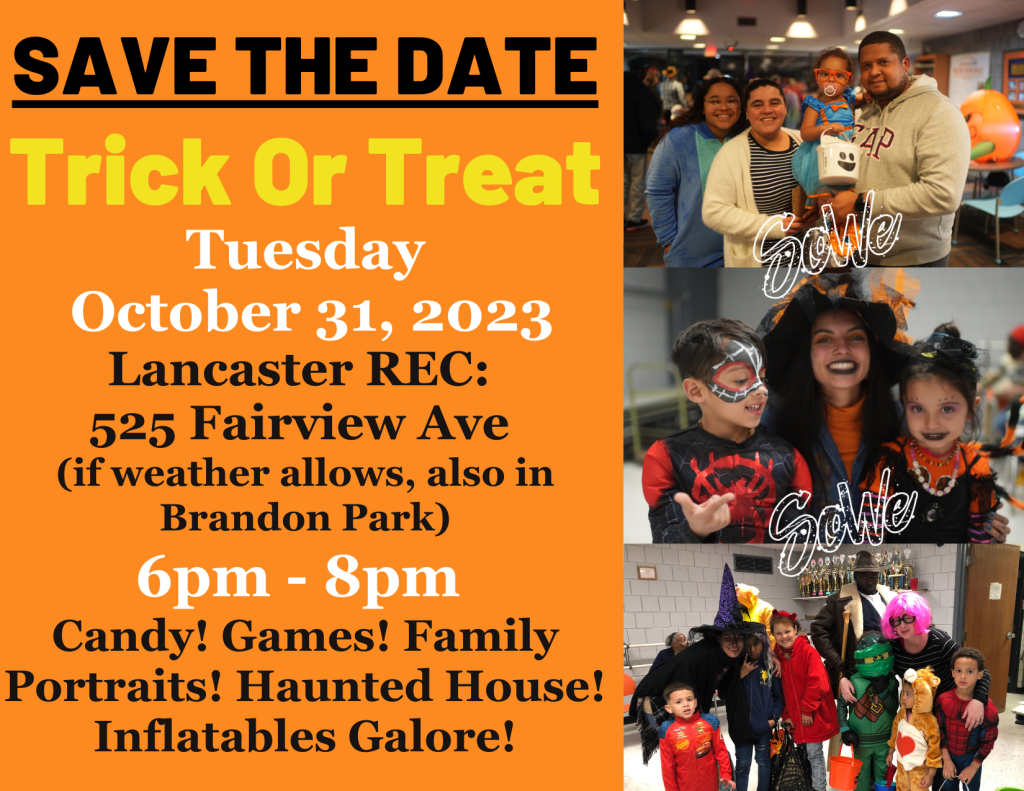
Join your neighbors on Tuesday, October 31 for SoWe’s annual Trick or Treat celebration! If you’re interested in volunteering during this event, you can sign up here.


Join your neighbors on Tuesday, October 31 for SoWe’s annual Trick or Treat celebration! If you’re interested in volunteering during this event, you can sign up here.
This article is part of a series of posts from SoWe Volunteer Historian Jim Gerhart about the stories behind the stores on Old Cabbage Hill.
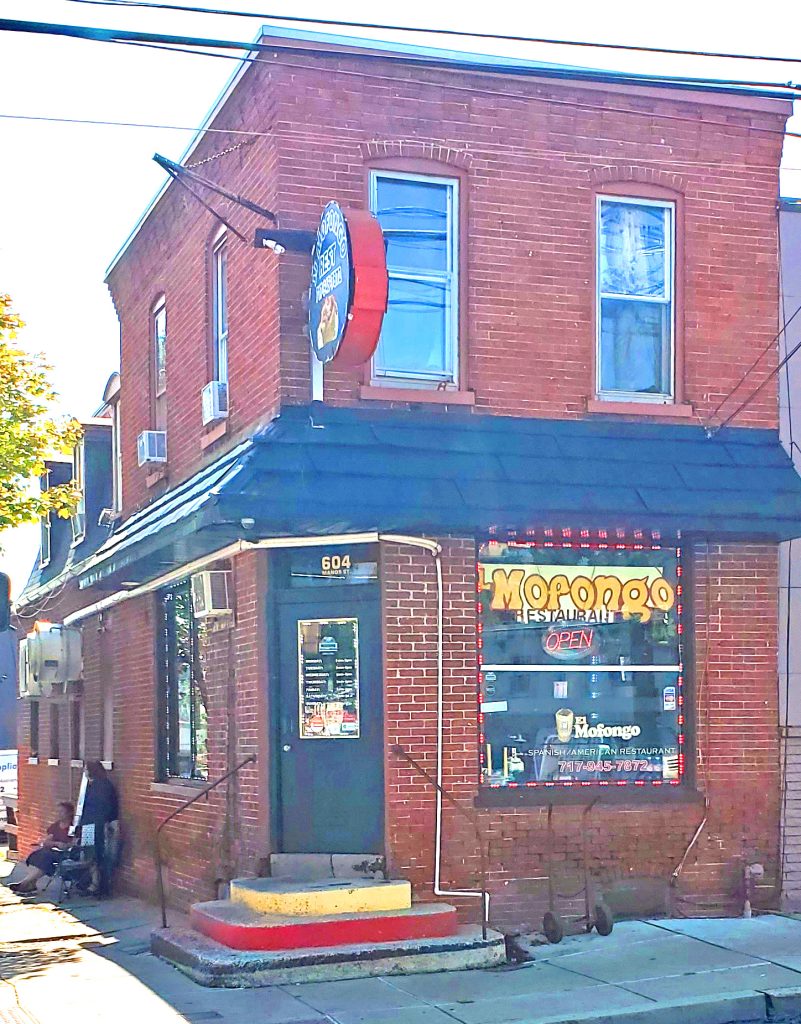
The two-story brick house and store at 604 Manor Street was built by Henry and Anna Mary Breiter in 1882, and it was owned by the extended Breiter family for its first seventy years. It was built on the fourteen-foot-wide southwest edge of Bethelstown lot 21. The other forty-eight feet of the lot’s frontage on Manor had been taken up by the construction of New Dorwart Street in 1881 when a small stream was buried in an arched brick sewer to make way for the new street.
Henry and Anna Mary built the narrow building at 604 Manor for use as a cigar factory. They lived on the second floor above where the cigars were made. Henry Breiter was an interesting character. He was born in Germany in 1830, immigrated to New York City in 1854, and settled in Lancaster in 1865, after serving in the 55th New York Volunteers in the Civil War.
Henry married Anna Mary Scheetz shortly after arriving in Lancaster, and for a while, he owned a cigar factory on Water Street. He also owned several other properties in the city and was a partner in the building of a hotel on South Queen Street. He bought Bethelstown lot 22 on Manor Street and built a cigar factory in the backyard, which burned down in 1877. In the late 1870s, the courts forced him to sell some of his properties to settle some debts.
Apparently, Henry had a short temper. In his first two decades in Lancaster, he had numerous run-ins with the law, including being charged with assault and battery several times. Henry was not a guy you wanted to provoke—he also was an officer and competition-winning member of the Germania Sharpshooters.
Anna Mary’s life ended disastrously. On the day after Christmas in 1900, at 604 Manor, she fainted while carrying a large pot of boiling water, spilling the water and scalding the left side of her body. She died a couple of weeks later of blood poisoning as a result of her burns. A little more than two years later, her husband Henry died at age seventy-three.
Anna Mary’s younger brother, Lorentz Scheetz, and his wife Ada, took over the cigar factory after the Breiters died, and lived on the second floor of the building. By the mid-1910s, Lorentz had modified the front part of the first floor at 604 Manor, adding a store where he sold the cigars that he was making. The angled doorway and the display windows near the corner of the building probably date to the mid-1910s, as does an overhanging cornice, now modified, that wraps around the corner of the building.
Henry L. Breiter, Henry and Anna Mary’s son, and his wife Minnie, operated the store for their uncle Lorentz Scheetz starting in the late 1910s and moved into the second floor of 604 Manor with the Scheetz’s. Lorentz eventually moved his cigar-making business to 47 Dorwart Street, where he continued making the cigars that Henry L. and Minnie Breiter sold in the store.
In the 1920s, Henry L. took a job as an inspector at Hamilton Watch Factory, and his wife, Minnie, took over the operation of the cigar store, adding candy to its inventory. Henry L. died in 1947, and Minnie continued to run the store after his death. Minnie apparently diversified her business: In 1951, the store was raided by the police and Minnie was arrested for taking bets on horse races. She served a month in the county jail for bookmaking.
Just as her mother-in-law, Anna Mary, had met a tragic end at 604 Manor during the Christmas season, so did Minnie. In the week before Christmas 1953, the building at 604 Manor caught fire. Minnie was discovered unconscious in her bedroom above the store and had to be rescued out of a second-floor window by a fireman. She died three days later as a result of smoke inhalation.
In 1954, following Minnie’s death, the store and house were sold for $21,200 to Anthony and Jennie Caterbone, who opened a branch of DeLuxe Cleaners in the store and rented out the second floor as an apartment. The cleaning business was in operation until 1975, and then the Caterbones leased the store to Zangari’s Pizza Parlor until 1980, when Louis Zangari bought the house and store from the Caterbones for $43,000.
Zangari’s Pizza Parlor was in business in 604 Manor until 1991, when the building was purchased by Lance Newswanger for $64,900. Newswanger opened Cabbage Hill Steak & Subs in the store, but within a year he changed the name to Three Adelphia Pizza & Subs, which was in business until 1998 when Newswanger sold the property to Anthoula Papadimitriou for $80,000. About 2006, the business in the store grew with the addition of another enterprise—Hit the Spot Pizza—to the continuing Three Adelphia business. The upstairs part of the building continued to be a residence, sometimes a rental and sometimes where the owner or store proprietor lived.
After Anthoula Papadimitriou’s death, her estate sold the property to Thomas Haines in 2008 for $110,000. Average Joe’s Pizza replaced Hit the Spot in 2010, and then in 2013, Par Café was added to the mix. In 2016, J&J Mofongo Restaurant opened, joining Par Café and Three Adelphia in the store. Then, from 2017 to the present, J&J Mofongo Restaurant has been the sole business in the 141-year-old store at 604 Manor, with Gabriel De Jesus owning the building until it was purchased by Dustin & Gary LLC in 2022.
This article is part of a series of posts from SoWe Volunteer Historian Jim Gerhart about the stories behind the stores on Old Cabbage Hill.
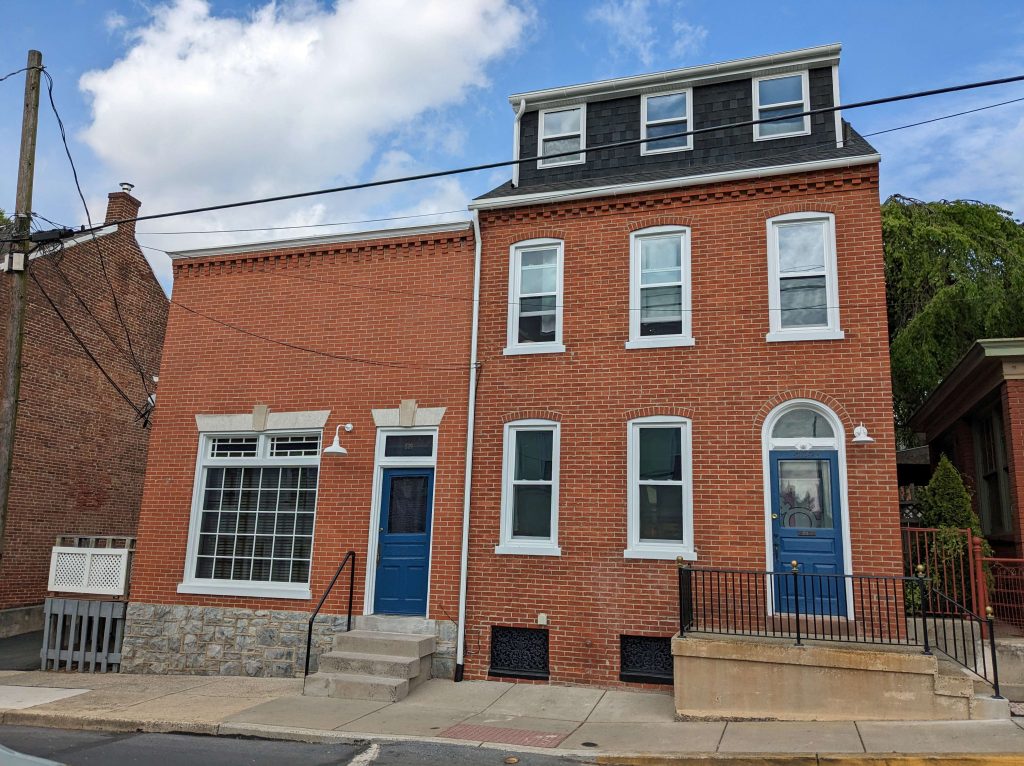
Close to the corner of East Filbert and St. Joseph Streets, across from the green “Welcome to Cabbage Hill” house, is a two-story brick house with adjoining shop that was the headquarters of the meat business for four generations of the Falk family for nearly 100 years.
Charles Falk, Sr. and his wife Frances immigrated to America from Germany about 1850, when they were in their early twenties. He and Francis went on to have four sons and one daughter. Charles, Sr. was a shoemaker, and he worked in that trade for several decades in their log house at 516 High Street.
In 1883, the Falks, in their son Charles, Jr.’s name, bought the lot where 509-509A are located today. The lot was on the northwest side of St. Joseph Street, fifty-five feet wide and extending back to West Vine. By 1885, Charles, Sr. had given up his shoemaker business, and he and his sons had built a two-story brick house facing St. Joseph (now 509A), with a butcher shop and slaughterhouse behind it on West Vine. Charles, Sr. and Frances lived in the house, while their sons Charles, Jr, and Louis continued to live at 516 High while they worked at the butcher shop.
The business got off to a rough start. On a Sunday morning just after Christmas in 1885, shortly after moving into the new house and starting the meat business, Charles, Sr. had an accident while delivering meats. He was traveling in his new wagon on Chestnut Street at Water Street when he almost was hit by a passing train. He barely avoided the collision, but the scared horse bolted and veered into a lamp post, destroying the wagon, which he had just bought a few weeks earlier. The wagon and a new harness were a total loss at $150. Charles, Sr. was not seriously injured, and the horse survived.
Frances died in 1895 and Charles, Sr. died in 1902. Their sons, Charles, Jr. and Louis took over the family meat business, which they named Falk Bros. Meats. About 1920, they built a shop, or meat market, on the southwest side of the house. This is the small building (now numbered 509) that still stands next to the house (now numbered 509A).
By the mid-1920s, the next generation of Falks had taken over the business. Charles III and Louis Falk continued to sell meats under the name of Falk Bros. Meats. They were quite successful, selling meats in their shop, delivering meat to customers, and operating meat stands at Central, Southern, and Northern Markets. Louis also branched out into property management, when in 1923 he purchased the grouping of three houses next door at 513-17 St. Joseph for rental income.
The fourth generation of Falks took over the business by the 1940s. Robert and Richard ran Falk Bros. Meats for several more decades, until they closed the business in 1980, making it nearly 100 years that the Falks had been in the meat business on St. Joseph Street. Increasing Pennsylvania health regulations were part of the reason for their closing in 1980.
Over the years, the Falks had built quite a complex of buildings on their property. In addition to the house and shop facing St. Joseph, and the slaughterhouse facing West Vine, they built a smokehouse, a rendering shop, a wagon house, a wagon-loading stage, and later a garage for cars and trucks.
In the mid-1980s, after the business had closed, the house remained a residence, the slaughterhouse was converted to apartments, and the shop remained vacant. By about 1990, the shop was converted to an apartment as well. In 2022, Mike Brenneman, who lives on the same block, purchased the property and began repairing and updating the apartments. He also opened up the display window in the shop that had been closed up when it was converted to an apartment. See the photo for the renovated buildings.
Jim Gerhart, 2021
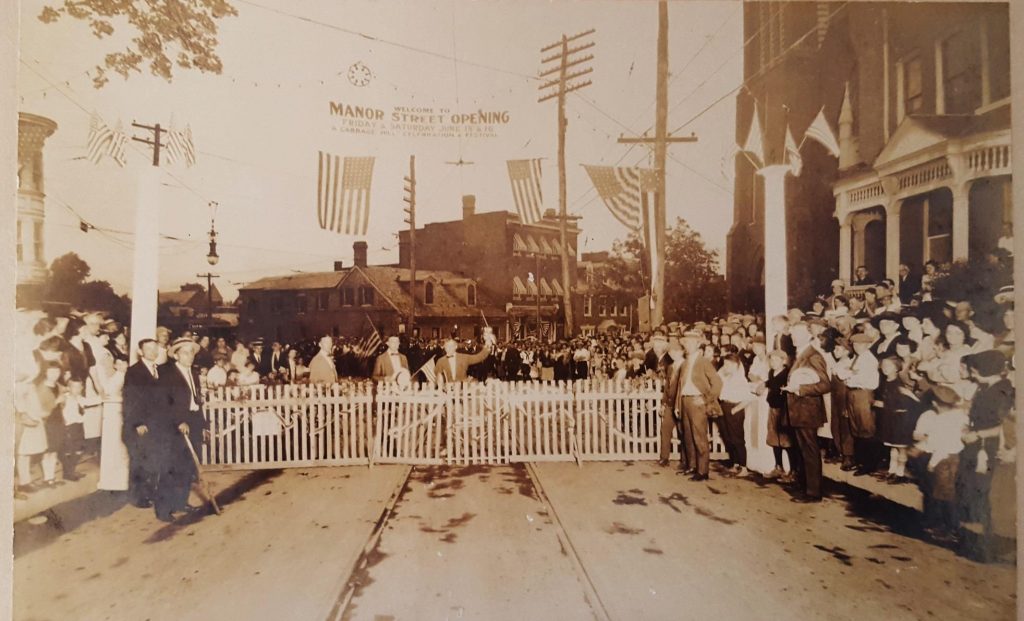
Using your smartphone or tablet as your guide, take a stroll down Manor Street at your own pace and discover the history behind some of the old houses and other buildings on Manor Street. Also, get to know some of the interesting people responsible for the growth of Manor Street and its various businesses in the mid 1800s to early 1900s.
Installation of the Artful Intersection planned for the top of Cabbage Hill will commence on Sept. 11, followed by a Community Paint Day on Sept. 18. Motorists should be advised of street closures in the area on both days.
September 11 | 7 a.m. to 4 p.m.
– W. Vine St. at E. Filbert St.
– W. Strawberry St. between Vine St. and St. Joseph St.
September 18 | 7 a.m. to 4 p.m.
– W. Vine St. at E. Filbert St., and between St. Joseph St. to W. Strawberry St./Mulberry St. intersection
– W. Strawberry St. at High St., and between Vine St. and St. Joseph St.
– S. Mulberry St. at King St.
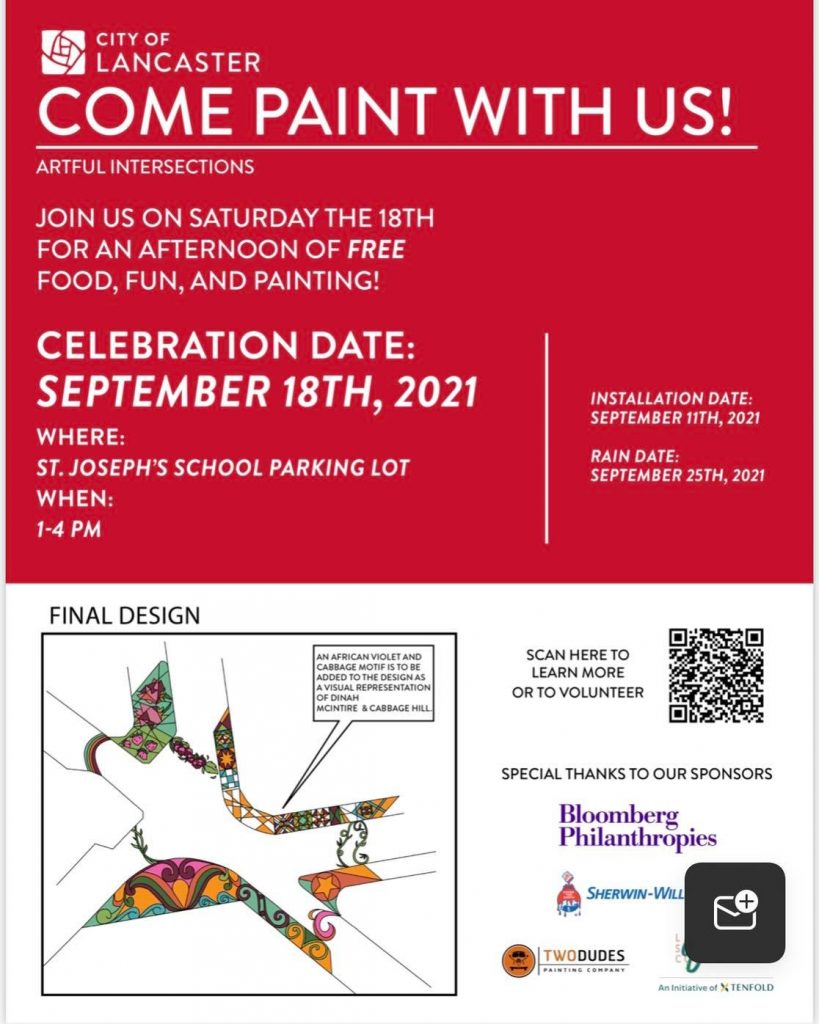
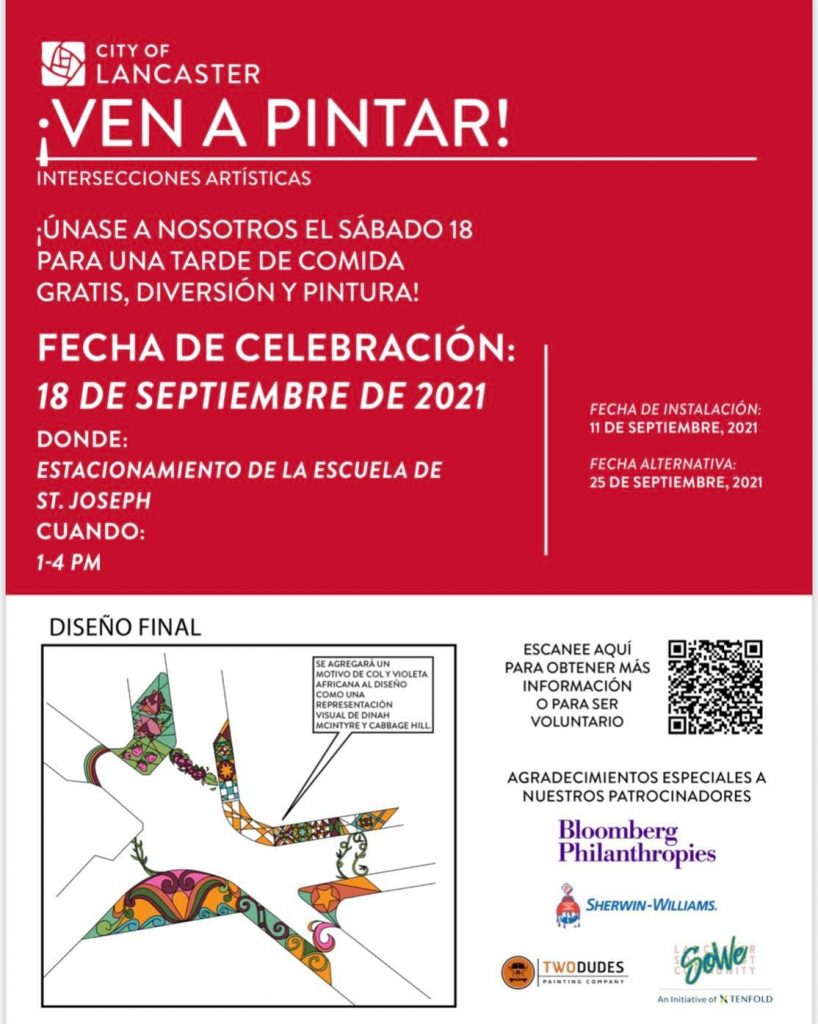
Residents living on W. Vine St. may use the St. Joseph’s Church parking lot as a detour thru to St. Joseph St. between 9 a.m. and 4 p.m. on both days of closure. All motorists should follow posted detours on both days of closure.
A street mural created by artist Fern Dannis in partnership with Peter Barber of Two Dudes Painting Company using input from the community will help improve pedestrian safety and enhance public space at the intersection of W. Strawberry St., W. Vine St. and S. Mulberry St.
This five-way intersection is a sometimes-confusing space integral to neighborhood and city-wide traffic circulation. The artful intersection is expected to expand the perceived public space to encompass the street; increase awareness and safety of alternative forms of transportation, and boost community development.
The project team welcomes the community to attend the Community Paint Day on September 18. Those wishing to volunteer can sign up at here.
Dannis and Barber were selected by a project team, including site neighbors, arts professionals and a Public Art Advisory Board (PAAB) member.
This project is part of the Bloomberg Foundation’s Asphalt Art Initiative grant program, which embraces art as an effective and relatively low-cost strategy to activate their streets. The City of Lancaster is one of 16 cities to receive this grant, in partnership with SoWe, a resident-led community initiative of Tenfold (formerly Tabor/LHOP).
For more information about Artful Intersections and the project process, visit engage.cityoflancasterpa.com/en/projects/artful-intersections-cabbage-hill.
Follow-up survey launches to track SoWe initiative’s progress and future planning

SoWe, an initiative of Tenfold, announced the launch of a follow-up survey that will give Southwest Lancaster residents an opportunity to share their feedback on current neighborhood needs, resource gaps, and the impact of SoWe investments that have occurred since the original survey and SoWe initiative was launched in 2016. This will give the SoWe initiative the opportunity to track progress made over the past five years and shape planning efforts for the next five years.
The follow-up survey will mirror the original survey that was conducted as part of the Wells Fargo Regional Foundation Neighborhood Planning Grant in 2016. Millersville University’s Center for Public Scholarship and Social Change will work with the SoWe initiative to administer the follow-up survey and complete the data analysis.
SoWe residents will receive the survey via a mailing and other activities that are planned over the next couple months. SoWe residents can complete the survey by clicking here. SoWe residents are strongly encouraged to participate, as their feedback will be used to set the vision, strategy and objectives for SoWe neighborhood investment over the next five years.
Since inception, the SoWe initiative has leveraged over $5.8 million dollars to support the SoWe neighborhood and its residents. By listening to neighborhood feedback, the SoWe initiative has invested in affordable housing, public parks and street scape, youth programing and education, community safety, neighborhood connections and economic opportunity. Major successes of the SoWe initiative include the renovation of Culliton Park, the establishment of Price Elementary as a Community School, renovation of neighborhood housing for affordable homeownership and rental opportunities, investments into private housing to include an Affordable Home Repair program and the Façade Improvement Program.
A big thank you to all the residents who came out to Two Dudes Painting Co. for the Strawberry Hill Artful Intersection Community Engagement Session. If you were not able to attend, do not worry, here is a recap with meeting materials and videos!
The session started with a brief Powerpoint presentation by Fern Dannis with examples of other asphalt art projects, project scope, and timeline. Jim Gerhart outlined the historical context of this intersection.
Participants were given site maps and tracing paper to make notes or sketches, along with a handout of suggested ideas.
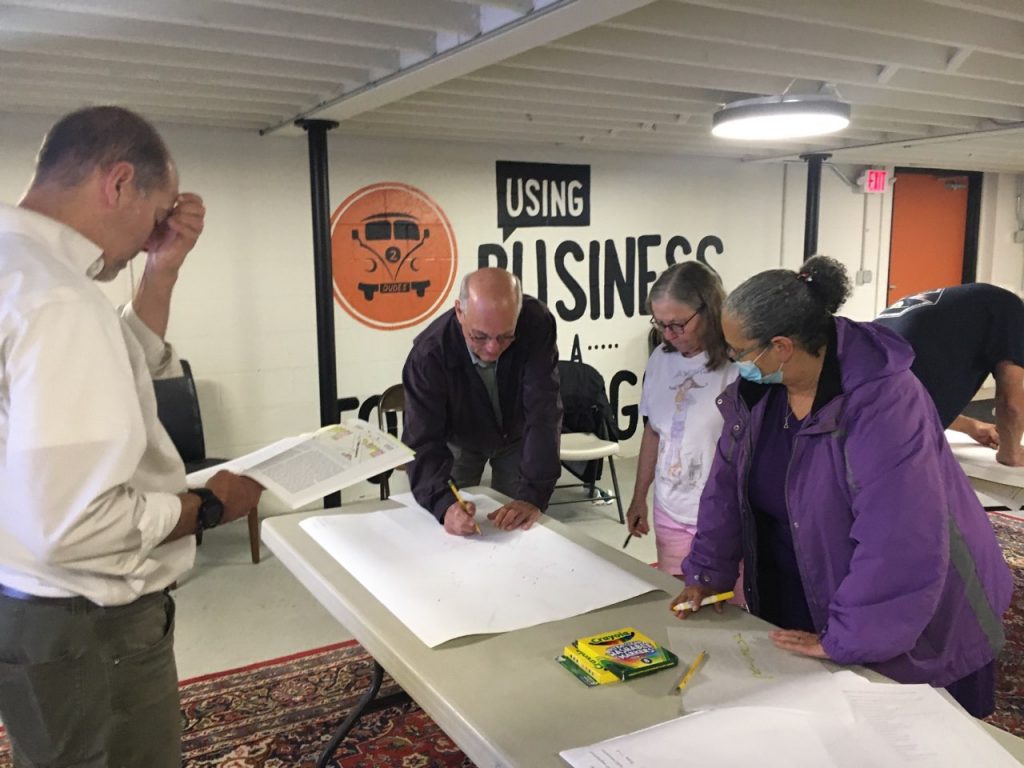
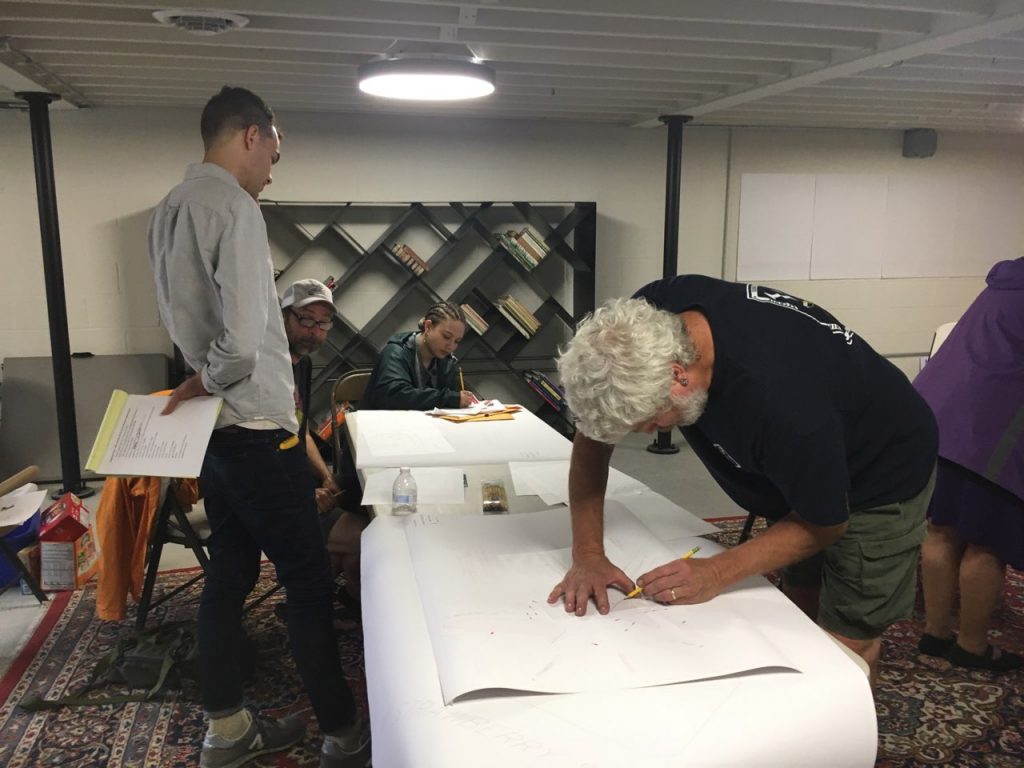
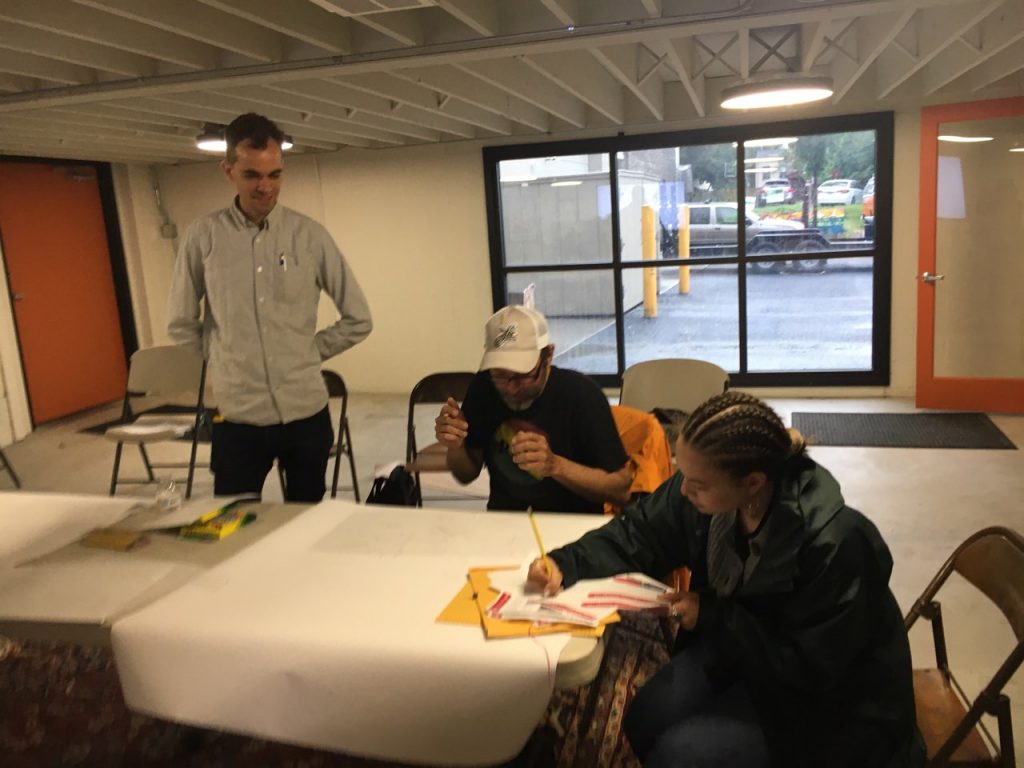
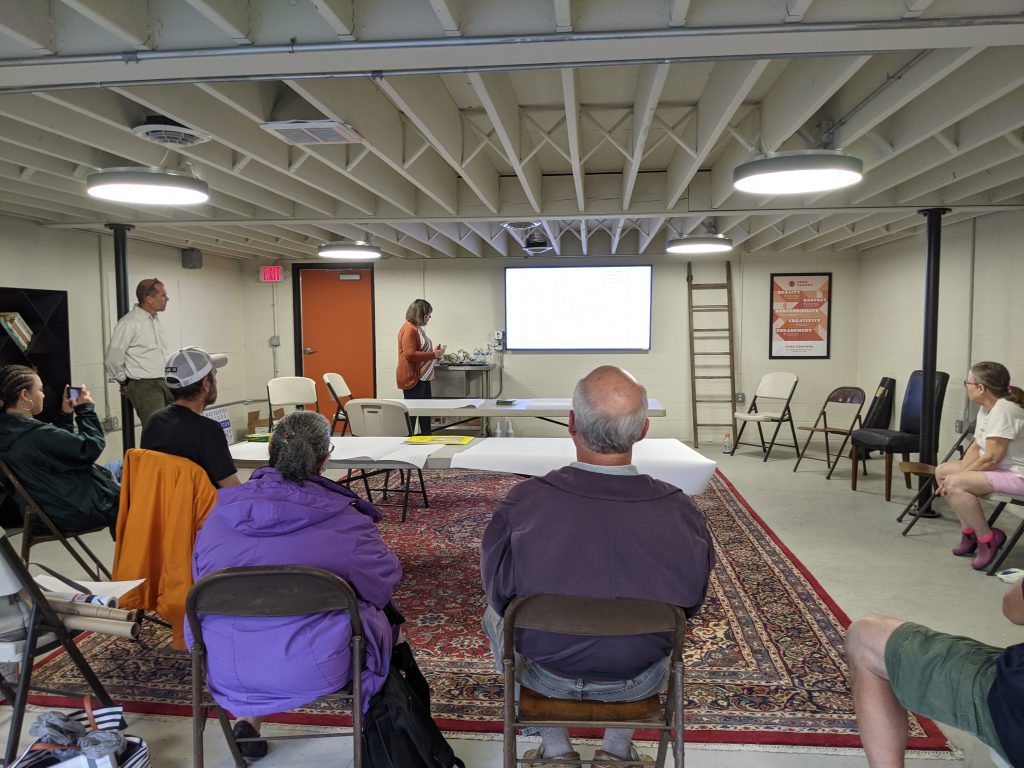
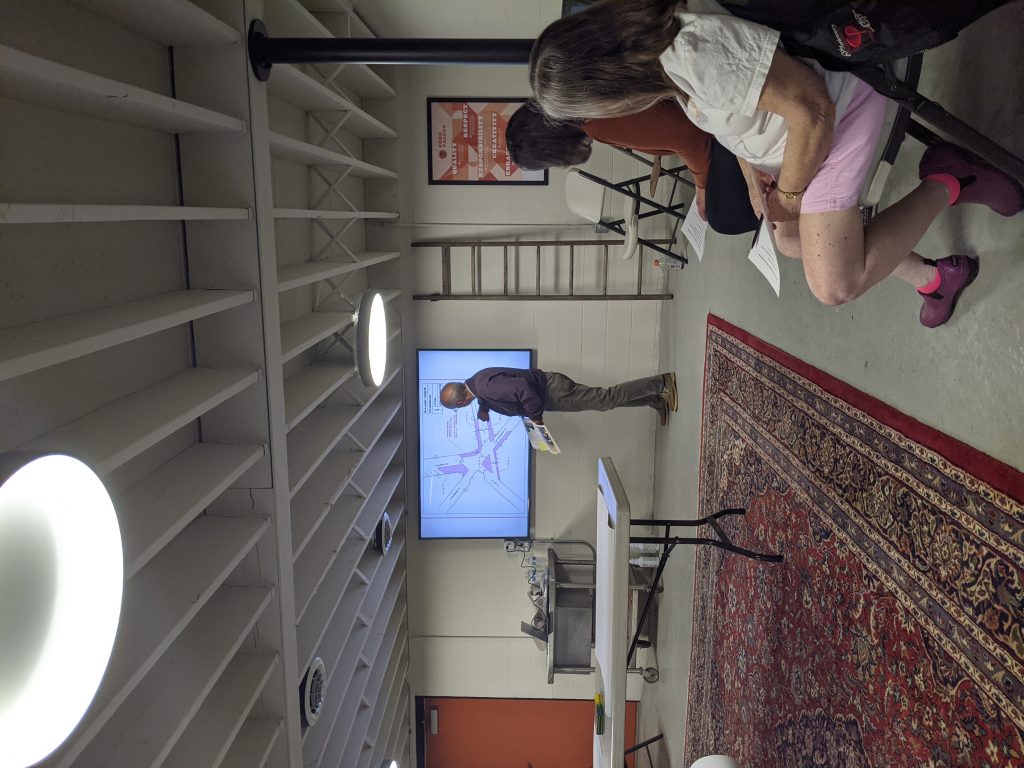
Project Engagement Timeline:
May 28 – Community Survey launched on engage.cityoflancasterpa.com.
June 3 – Mini Artist Workshop Session #1, @Two Dudes from 5:00pm – 7:00pm
June 17 – Mini Artist Workshop Session #2, Culliton Park from 5:00 – 7:00pm
June 22 – Mayor’s Neighborhood Week Event at Culliton Park – Project Outreach
June 26 – Mini Artist Workshop Session #3, @ St. Joseph’s school parking lot, from 10am – 12pm
June 28 – Community Survey Closes
July 16 – Artist Team to Present Mural Concepts for Feedback
August 6 – Mural design Finalized
September - Project installation - September 11th, Rain Date Sept. 18th

Hello SoWe ! Let’s make some art.
The City of Lancaster is working with local artist, Fern Dannis, along with Two Dudes Painting Company to create an artful intersection at the Strawberry Hill intersection. This project is part of the Bloomberg Foundation’s Asphalt Art Initiative to create street murals and other creative interventions to improve pedestrian safety and enhance public spaces.
The intersection of West Strawberry Street, West Vine Street, and South Mulberry Street sits at the top of Cabbage Hill. This five-way intersection is a confusing space for pedestrians and vehicles and is integral to the neighborhood and city-wide traffic circulation. Public engagement is beginning June 3rd, with the artwork being designed over the summer. The final application of paint-to-asphalt is set for September 11, 2021.
Community Engagement Sessions dates are below and are open to the public! Join us!
June 3rd 5:30 – 7:00 at Two Dudes Painting Co.– 750 Poplar St. Lancaster, PA 17603
June 26th 10:00 – 12:00 at 47 S. Mulberry St. Parking Lot
Cant make the community events but still want to provide feedback? Fill out this survey.
What is an artful intersection?
Artful Intersections connect artists and neighbors to work together to create street murals in their neighborhoods. The street murals serve as a reflection of the life and culture of the neighborhood; it is expected to expand the perceived public space to encompass the street; increase awareness and safety of alternative forms of transportation, and boost community development.
To learn more about the project, please visit https://engage.cityoflancasterpa.com. We are asking residents to respond to a community survey to provide input on pedestrian safety and the artwork for the intersection.
To view similar asphalt art projects, visit the Bloomberg Asphalt Art Initiative Website https://asphaltart.bloomberg.org/.
Jim Gerhart, May 2021
Cabbage Hill was nothing but forest, farmland, and pasture until 1762 when Bethelstown was laid out with 66 building lots on the first two blocks of what would become Manor and High Streets. Bethelstown grew slowly; by 1815, more than 50 years after its founding, there were only about 25-30 houses on its 66 lots. Nearly all of the houses were one-story houses made of logs and rough-sawn wood.
Most of the original houses on Manor and High were later replaced by two- and three-story brick houses built in the second half of the nineteenth century. However, at least one of the charter-member houses of old Bethelstown lasted well into the twentieth century before being razed—a log house with weatherboarding that used to stand at 442 Manor before it was taken down in 1963 to make room for a parking lot.
Which raises the question: Was 442 Manor the only survivor of the original 25-30 one-story houses from old Bethelstown, or is it possible that more of the original one-story houses are still present, hiding behind modern vinyl siding and form-stone? Most of the historical sources needed to answer this question are available online. The only one not completely online is county tax lists, and the staff of LancasterHistory was kind enough to supply the lists for the years not yet online.
Using Google Maps, I was surprised to discover that 27 one-story houses are still present in the 400 and 500 blocks of Manor and High. Of the 27, nine are single houses, fourteen are in seven house pairs, and four are grouped together in a connected row of houses. Using newspaper articles, city directories, street maps, property deeds, and other sources, I was able to determine that 20 of the 27 current one-story houses in the first two blocks of Manor and High were built in 1850 or later, and therefore are not old enough to be original houses from old Bethelstown. The remaining seven possibilities—two on Manor and five on High—were investigated in more detail.
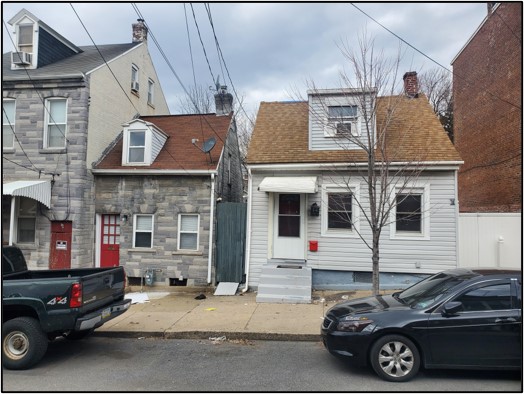
Of the seven houses that predate 1850, five were found to have been built in the 1840s, leaving just two—433 and 435 High Street—that had the potential to be old enough to be original Bethelstown houses. A couple of key deeds and tax records show that these two one-story houses, which are next-door neighbors on the northwest side of the 400 block of High, were built on Bethelstown lot 28, and that both houses were already present in 1840. The deeds show that 433 is a log house, adding to the potential that it could have been built quite a bit before 1840.
Making things a little more challenging, detailed maps and city directories do not exist before 1840, and many pre-1840 deeds that would be helpful seem to have gone unrecorded or have been lost. Consequently, tax lists took on a more important role in tracking these two houses before 1840. The continuity from year to year in the amount of ground rent paid for the lot, as well as the assessed value of the houses, enabled me to trace 433 and 435 High back in time before 1840 with some success. Also helpful were occasional notes written by the tax assessor when the properties were bought or sold.[1]
The result is that “YES” is my answer to the question of whether any of the 25-30 houses from the pre-1815 days of old Bethelstown have survived. The weight of the evidence points to the one-story log house at 433 High as the oldest surviving house on the Hill. It appears to have been built no later than about 1801, and possibly earlier. Not surprisingly, because they are neighboring houses on the same original lot, the one-story frame house at 435 High also is old, having been built about 1814. I believe these two are the oldest surviving houses on Cabbage Hill—older by at least a couple decades than Catharine Yeates’ 1838 summer cottage at 613 Fremont, previously considered the oldest survivor.

So, who built these historic houses at 433 and 435 High, and who were their early owners? The early history of the houses involves a couple generations of the Bier family. Peter Bier, Sr. (1701-1781) was a German immigrant who arrived in this country in 1748, bringing with him a teenaged son, Peter, Jr. (1732-1801), and settling in Lancaster about 1760. Peter, Jr. was a cordwainer (shoemaker) living in the southeast part of the city, but owning several other houses and significant acreage, including on the Hill. Peter, Jr. married Elizabeth Buch in 1760 at First Reformed Church, and they had a son, Peter III (1763-1843). Peter III also was a shoemaker, but later in life a farmer. Peter III and his wife Catharine had several children, including a fourth-generation Peter (1797-1849) who became a doctor.
Peter Bier, Jr., who died in 1801, appears to have acquired Bethelstown lot 28 shortly before his death. Peter, Jr. may have built the house now at 433 High as soon as he acquired the lot, or the lot may have already had the house on it when he acquired it. If Peter, Jr. built it, the house dates to about 1800-01; if lot 28 already had a house on it when he bought it, the house dates to the late 1700s and was built by an unknown first owner. I suspect the house was already there when Peter, Jr. bought the lot, because he died within six months, and probably would not have had the time to build a house. This means the house likely was built in the late 1700s.
As part of Peter, Jr.’s estate, lot 28 and the house on it was inherited by his widow Elizabeth. She may have lived in the house for a short time, but mostly she rented the house to a series of tenants, including, in the years immediately following Peter, Jr.’s death, to John Williams, a young mason who decades later would end up owning most of the land in the southern half of Cabbage Hill. Also, a few records suggest that John Drepperd may have lived in the house in the early 1810s. Drepperd was a gunmaker whose father and grandfather were both famous gunmakers supplying rifles for troops in the Revolutionary War.
Sometime about 1814, the widow Bier (or her son Peter III) seems to have added a frame house to lot 28 (now 435 High). Both houses were occupied by tenants for the next 10 years or so, but then, about 1824, Elizabeth transferred the deed for the lot and houses to her son Peter III. Peter III continued to rent the houses to tenants up until 1841 when he sold lot 28 and both houses to Jacob Liphart, a real-estate investor who lived in Marietta.
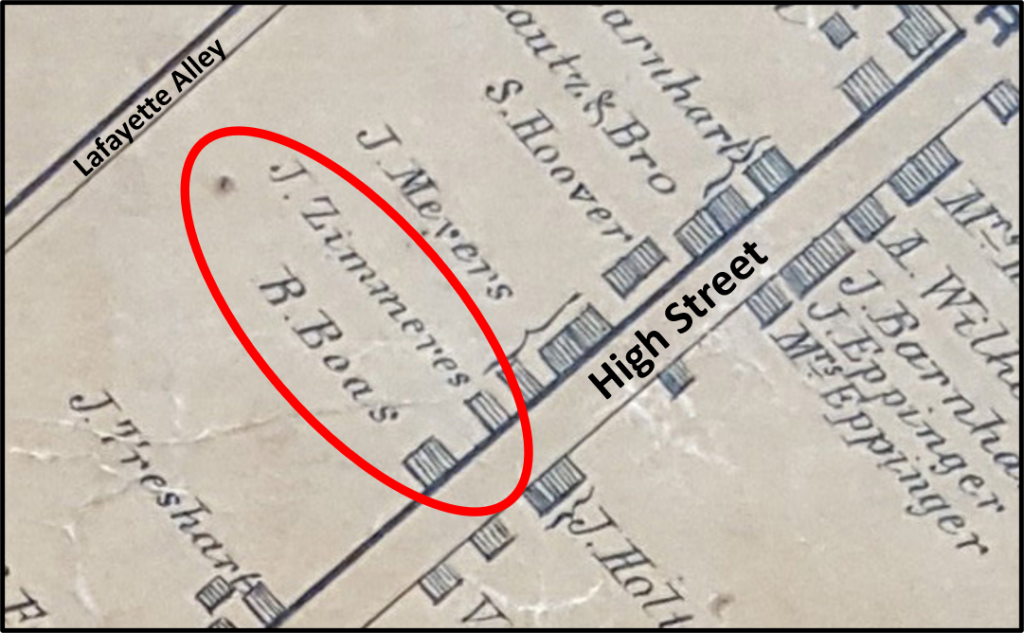
Liphart rented the houses out for a short while, and then split the 62-foot-wide lot in half, with the northeast half containing the one-story log house now numbered 433 High, and the southwest half containing the one-story frame house now numbered 435 High. In 1844, Liphart sold the half with 433 to John Zimmerer, a middle-aged tailor and his wife Sarah. Earlier, in 1842, Liphart had sold the half with 435 to Robert Boas, a middle-aged laborer, his wife Franciska, and their young son. Both Zimmerer and Boas were German immigrants, and both families lived in the houses they had bought, each of which was valued at $220 in 1845.

John Zimmerer died in 1857, and his wife Sarah sold the log house at 433 to Jacob and Susan Glassbrenner for $300. The Glassbrenner family lived in the house for a few years and then rented it out to tenants. After Jacob died, his widow Susan, who had moved to Philadelphia, sold the house to William Lebkicher in 1906.
Robert and Franciska Boas lived in the frame house at 435 High for many years. Sometime in the 1860s, they added the two-story brick house next door at 437 High, squeezing it into the remaining part of their lot. Boas and his wife moved into the larger 437 and rented 435 out to tenants until Boas’s death. In 1881, the frame house at 435 High and its larger brick companion at 437 were sold as part of Boas’s estate for $1,000 to John Kirsch. In 1920, after Kirsch had died, the courts granted the property to his widow Barbara at a value of $500 as part of her widow’s exemption.
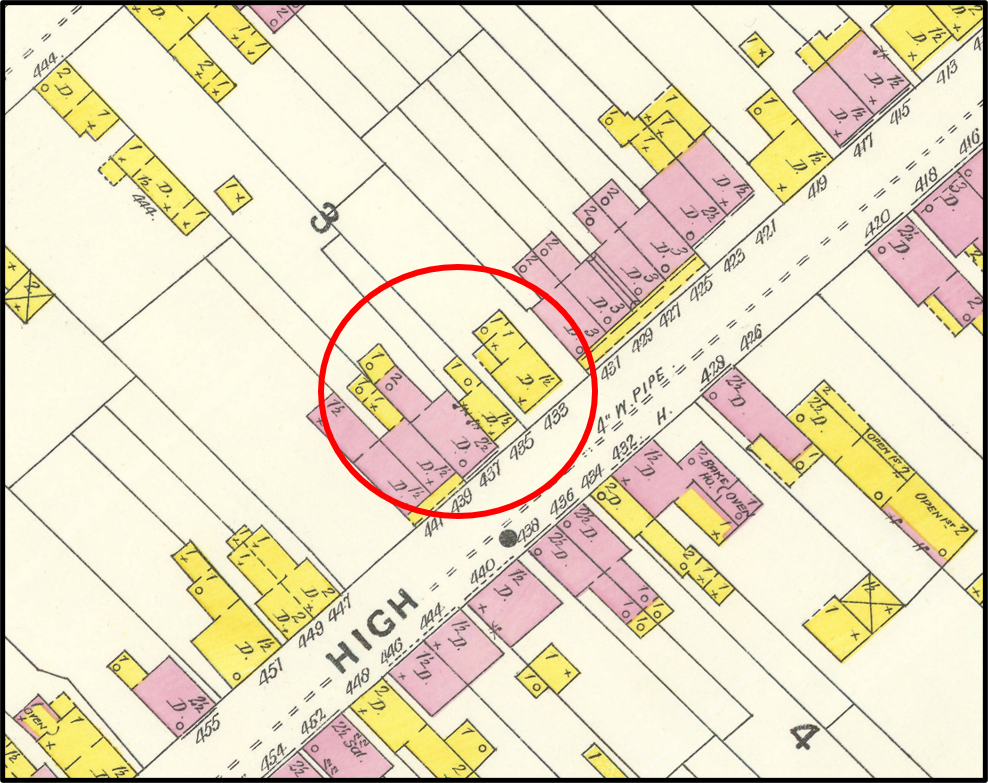
Today, Peter Bier III would have difficulty recognizing his houses. The one-story log house at 433 High is covered with vinyl siding, and the one-story frame house at 435 High is sheathed in gray form-stone. Both houses have had their original doors, windows, and roofs replaced. Dormers have been replaced or enlarged, and concrete steps now lead up to the front doors. But behind all the modern features, more than 200 years of history lie hidden.
It is my belief that 433 and 435 High Street are the only two houses that survive from the original 25-30 houses built in old Bethelstown between 1762 and 1815. Since Bethelstown preceded the development of the rest of the Hill, these two houses also are the oldest surviving houses on all of Cabbage Hill.
Sometimes a little historical sleuthing can uncover some remarkable stories hiding just behind modern siding and form-stone on the old houses on the Hill.
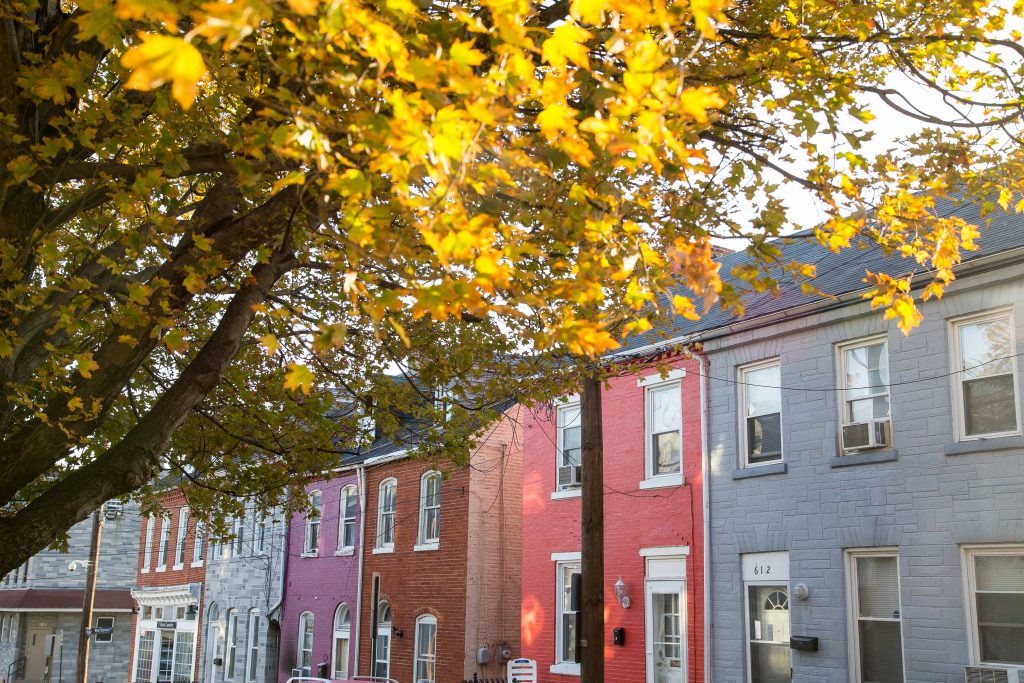
Lancaster City Alliance is accepting Façade Grant applications from May 1st to June 15th. SoWe residents are eligible to apply for funds to improve the exterior of their homes. This a matching grant; residents and businesses are eligible to receive up to $5,000 per property. For program details and to see if you qualify contact Alex Otthofer at aotthofer@teamlanc.org or 717.696.6206. Staff is available to assist in English and Spanish.
More information about the Façade Program can be found on our website here
SoWe also offers a low cost, low interest loans for residents to make necessary repairs to their homes through our Home Repair Program. Home Owners are encouraged to apply if they need financial support to make renovations. Applicants are required to find their own contractors. Contact Jake Thorsen if you’re interested in learning more about the program!